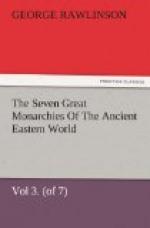Among insects, travellers chiefly notice the mosquito, which is in many places a cruel torment; the centipede, which grows to an unusual size; the locust, of which there is more than one variety; and the scorpion, whose sting is sometimes fatal.
The destructive locust (the Acridium peregrinum, probably) comes suddenly into Kurdistan and southern Media in clouds that obscure the air, moving with a slow and steady flight and with a sound like that of heavy rain, and settling in myriads on the fields, the gardens, the trees, the terraces of the houses, and even the streets, which they sometimes cover completely. Where they fall, vegetation presently disappears; the leaves, and even the stems of the plants, are devoured; the labors of the husbandman through many a weary month perish in a day; and the curse of famine is brought upon the land which but now enjoyed the prospect of an abundant harvest. It is true that the devourers are themselves devoured to some extent by the poorer sort of people; but the compensation is slight and temporary; in a few days, when all verdure is gone, either the swarms move to fresh pastures, or they perish and cover the fields with their dead bodies, while the desolation which they have created continues. [PLATE III., Fig. 2.]
[Illustration: PLATE III.]
Another kind of locust, observed by Mr. Rich in Kurdistan, is called by the natives shira-kulla, a name seemingly identical with the chargol of the Jews, and perhaps the best clue which we possess to the identification of that species. Mr. Rich describes it as “a large insect, about four inches long, with no wings, but a kind of sword projecting from the tail. It bites,” he says, “pretty severely, but does no harm to the cultivation.” We may recognize in this description a variety of the great green grasshopper (Locusta viridissima), many species of which are destitute of wings, or have wing-covers only, and those of a very small size.
The scorpion of the country (Scorpio crassicauda) has been represented as peculiarly venomous, more especially that which abounds in the city and neighborhood of Kashan; but the most judicious observers deny that there is any difference between the Kashan scorpion and that of other parts of the plateau, while at the same time they maintain that if the sting be properly treated, no danger need be apprehended from it. The scorpion infests houses, hiding itself under cushions and coverlets, and stings the moment it is pressed upon; some caution is thus requisite in avoiding it; but it hurts no one unless molested, and many Europeans have resided for years in the country without having ever been stung by it. [PLATE III., Fig. 3.]
The domestic animals existing at present within the limits of the ancient Media are the camel, the horse, the mule, the ass, the cow, the goat, the sheep, the dog, the cat, and the buffalo. The camel is the ordinary beast of burden in the flat country, and can carry an enormous weight. Three kinds are employed—the Bactrian or two-humped camel, which is coarse and low; the taller and lighter Arabian breed; and a cross between the two, which is called ner, and is valued very highly. The ordinary burden of the Arabian camel is from seven to eight hundredweight; while the Bactrian variety is said to be capable of bearing a load nearly twice as heavy.




